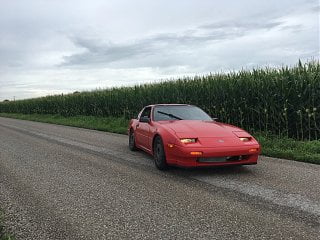hotter coolant temp while driving
-
 edizzle89Member
edizzle89Member- 82
hotter coolant temp while driving
My turbo 87 Z is an aftermarket temp gauge with the sender in the lower intake on the passenger side (pretty sure its the stock location for the dash gauge). I talked to the previous owner and he said it had a stock thermostat in it which would be 170 but i know 180's are available as well so it could be either. I have notice on my new commute to work since moving further away that the temp gauge will get up to ~200 after about 10-15 minutes of driving at 60-65 mph but will slowly go back down to ~180 after sitting and idling for a few minutes. It has a new radiator in it so it shouldnt be clogged.
I assume the lower intake gets its coolant flow from the heads which i have heard will show the hottest coolant temps, up to 15-25 degree's hotter then the thermostat temp, so maybe im just being paranoid. Has anyone else seen higher temps at the lower intake then what there thermostat is rated for? Another thing is that the car has a fmic and i dont know if it's maybe disrupting air flow to the radiator at high speeds, maybe i need to add some ducting between the bumper and the radiator to keep the air flowing into it?
you can see my FMIC in the picture for reference.Last edited by edizzle89; 07-20-2017, 09:38 AM.if you're gonna be dumb you gotta be tough -
 daniel_pearceSenior Member
daniel_pearceSenior Member- 173
The same thing happens to my 85 Turbo even though I have plenty of coolant, and the cooling system was flushed before I bought the car last summer. Clutch fan operation is normal and the radiator and hoses show no signs of wear. Due to these facts I suspect it may be the sign of a bad radiator cap. The radiator cap is a two way valve that holds coolant inside and also maintains pressure. A sign that it's bad is overheating. If pressure isn't maintained properly, the coolant can boil over and evaporate. If the coolant has escaped, or it isn't allowed to move freely, the engine can overheat rapidly. Our engines have probably been OK for now because the cap is showing early signs of failure. Also, other things help keep the engine cool enough like the fact that there's still coolant in the radiator, air flow from driving at highway speeds, and air flow from the fan. Your mechanic can easily test the radiator cap for you. If you'd prefer to do it yourself, check the top and bottom seal on the cap and make sure they're in good shape with no nicks or cracks. Also, make sure the valve spring raises with no problems. I just hope I don't need a new one because I have the original cap with the Japanese writing on it. Last edited by daniel_pearce; 07-21-2017, 06:49 PM.
Last edited by daniel_pearce; 07-21-2017, 06:49 PM. -
 FrozenZSenior Member
FrozenZSenior Member- 584
Here, Japanese AND Spanish and only $8.95 (though I bet it's out of stock.)
http://www.thezstore.com/page/TZS/PROD/16-7163
If you still have the original rad cap, yes, it has almost certainly gone bad by now lol. Radiator caps cost like five bucks. I don't understand why people don't change them more often.
-
 daniel_pearceSenior Member
daniel_pearceSenior Member- 173
Or if it is the rad cap and you want OEM, between $16.50 and $20.88 depending on what your local Nissan dealer charges.
https://balisenissanriparts.com/niss…partcode=21430
-
 edizzle89Member
edizzle89Member- 82
thanks for the info, i picked up a 170* thermostat (just so i know for sure what is in it) and a new radiator cap and ill make sure to bleed it really well so i'm not fighting with air in the system.if you're gonna be dumb you gotta be tough

